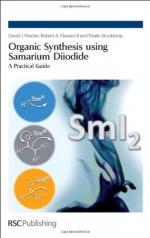|
This section contains 309 words (approx. 2 pages at 300 words per page) |
Samarium is a metal element signified by the atomic symbol Sm. Its atomic number is 62, and its atomic weight is 150.36. It is a yellow metal that tarnishes when exposed to air. It has a melting point of 1,965.2°F (1,074°C) and it boils at 3254°F (1790°C). Its abundance in the earth's crust is estimated at 4.5-7.0 parts per million.
The analysis of the rare earth materials that took place during the nineteenth century is characterized by a common theme. A chemist studies a mineral and finds in it at least one new substance. Shortly thereafter, a second chemist re-analyzes the new substance and finds at least one more new substance. The process is sometimes repeated again and again.
Such was the case with the discovery of samarium. In 1841, Carl Gustaf Mosander analyzed the oxide lanthana and concluded that it contained a new element which he named didymium. Nearly 40 years later, Lecoq de Boisbaudran reanalyzed didymium and found that it produced spectral lines that could not be assigned to any known substance. Boisbaudran concluded that didymium itself was not an element, but that it did contain an element, which he named samarium for the mineral in which it occurs, samarskite.
The story goes on. In 1880, Jean-Charles Galissard de Marignac (1817-1894) also worked with the same samarskite and discovered a second new element, later named gadolinium. Still later, in 1901, Eugène-Anatole Demarçay (1852-1903) reanalyzed the compound and found the element, europium.
Samarium is used in nuclear power plant control rods, in carbon-arc lamps, and in optical masers and lasers. An alloy with cobalt having the formula SmCo5 or Sm2Co17 is used in making the most permanent electromagnets yet developed. Compounds of the element are used in the manufacture of optical glass and phosphors and as catalysts in the production of ethyl alcohol.
|
This section contains 309 words (approx. 2 pages at 300 words per page) |


